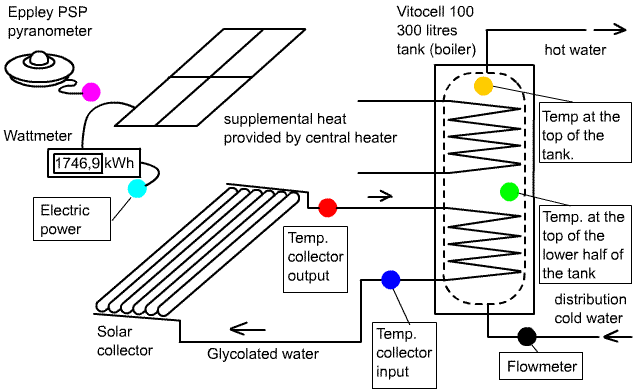

The collector consists of 30 glass vacuum tubes, each containing a black metal plate which absorbs solar radiation. A copper tube welded to each plate contains a pressured gas which serves as the heat transfer fluid which carries the heat collected in the tubes to a heat exchanger located in the upper part of the collector. This exchanger transfers the heat transported by the pressured gas to a second fluid which is glycolated water and which serves to convey the heat from the collector into the tank ( through the coil located in the lower half of the reservoir and a pump ). The circuit of the glycolated water is represented in the diagram above.
It should be noted that the glycolated water circulator shuts off whenever the output temperature of the coil (blue dot) reaches 70 °C. A maximum temperature of 70°C for the output of the coil has been set for safety reasons, otherwise the water temperature in the tank could potentially rise too high in the late afternoon and could present a burning hasard. When the temperature of 70 °C is reached at the output of the coil, the pump stops sending fluid to cool the solar collector. The temperature in the collector (red dot) rises in an uncontrolled way. It can reach 250 °C in summer, which is the temperature at which a radiative balance between the solar energy taken in by the collector and the energy lost by radiation due to its high temperature. The glycolated water circulating pump is allowed to restart when the temperature in the collector has fallen below 110 °C (at the end of the day or during a cloudy period).
The water in the reservoir is stratified i.e. composed of two layers: hot water on top and cold water underneath. There are two principles to keep in mind in order to understand the operation of the tank:
1) when a mass of water is heated at the bottom of a tank, it tends to rise in order to reach a higher level in the tank where the water has the same temperature (this is heat exchange by convection).
2) when a mass of water is heated at the top of the tank, it does not tend to mix with the colder layers of water that are below it. Therefore, virtually no heat is exchanged downwards (virtually no heat transfer by conduction).
The top half of the tank is heated by central heating, as with a conventional system. The bottom half is heated by the solar collector. In winter, the solar collector "preheats" the water which is then heated by the central heating in the upper half of the reservoir. In summer, the collector provides enough heat to run completely without any central heating ( which is of course turned off during this season).
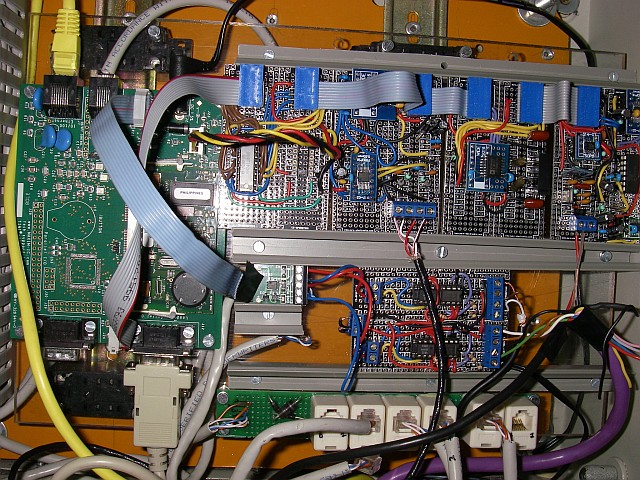
For the last four years, data on the eausolaire.eu site were collected using a computer (see history below). This computer (tower type) was constantly turned on and was consuming a significant amount of energy (100 W during 24 hours, that's 2.4 kWh per day!). We therefore decided to replace it with a microcontroller, which uses much less energy (a few watts). The current acquisition system is built around the Maxim Tini microcontroller. TINI (Tiny INternet Interface) is a product of created ten years ago by Dallas SemiconductorDallas (then later acquired by Maxim) to illustrate the concept of "coffee machine on the Internet," a concept that all domestic electrical equipment would soon be interfaced on the Internet, making it possible to monitor and control them remotely. The stand-alone TINI platform uses Java. Dallas devoted a team of talented engineers to TINI. Unfortunately; in 2011 Maxim decided to stop the production and sale of TINI and attributed the name TINI to a new line of products not related to the original one. IMSYS, a Swedish firm carries on the tradition and produces an equivalent to TINI, more powerful but quite expensive, called SNAP Classic. Systronics does the same with TStik. One advantage of TINI is that it allows direct use of a range of 1-wire sensors and devices, another interesting line of products created by the same team of engineers at Dallas. Another good reason for using TINI is because there is a wonderful book by Tim Bitson (see References) which explains in great detail how to set up a weather station and to connect it to the Internet using TINI. Our site was heavily inspired by the technical solutions and programs designed by Tim Bitson. To build an reliable data acquisition system resquired to protect it from electrical interference and lightnings due to the fact that some sensors are placed on a roof outside the house.We resolved this difficulty by discovering of a series of components and examples of circuits by Analog Devices that were ideally suited for our project (here, here, et here). The idea is to separate electrically the front end amplifier and the analogic converter from the TINI microcontroller using digital isolators. These are chips that integrate a set of several digital isolators together with a dc-to-dc converter. They provide a total isolation of both the logic signal and the 5 volt supply.
Temperature measurements in the hot water tank: 3 Dallas 1-wire sensors (Maxim ) DS18B20 directly connected to TINI. schematics
Temperature measurements in the thermal collector: Pt100 temperature sensor, analog to digital converter AD7792 in SPI protocol with integrated current source excitation and digital filtering for noise, connected to TINI's SPI port through a ADUM5401 digital isolator (isolator for digital signals and power supply). schematics
Irradiance measurement using the pyranometer: Harrison and Knight preamplifier (see References), AD8226 instrumentation amplifier, analog to digital converter AD7792 in SPI protocol with digital filtering of noise, voltage reference REF5040, shifting of the reference voltage by MCP609 operational amplifier, connected to Tini's SPI port through an ADUM5401 digital isolator (isolator for digital signals and power supply). schematics
The two AD7792 analogic-digital converters for measuring the thermal collector temperature and the pyranometer voltage are connected to TINI's SPI port through a 74LS244 multiplexer (making it possible to put two SPI devices on the same SPI port). schematics
Measurement of the output of the photovoltaic collector: Swissnox digital watt meter (Energy Meter) S25 inserted at the output of the inverter, giving two pulses for each watt hour produced, filtering of the pulses using a 555 as Schmitt trigger , 4N32 optocoupler, 1-wire DS2423 integrated circuit as pulse counter directly connected to TINI. schematics
Measurement of the hot water drawn out of the tank : Oval vortex flowmeter (Eggs Delta-Pulse), generating 4 pulses for one litre, filtering of pulses with a 555 as Schmitt trigger, 4N32 optocoupler, 1-wire DS2423 integrated circuit as pulse counter directly connected to Tini. schematics
All measurements are recorded at 1 minutes intervals and the measurements are send every hour by FTP to the eausolaire.eu site as an ASCCI file. The graphs are generated using the JPgraph PhP library.
The control and data acquisition of our solar energy system evolved over time. In March 2008, the heating system was equipped with a Vessmann Vitosolic 200 regulator, which provides a much more effective control than the old Vitosolic 100 regulator. The data acquistion system has changed several times. First we used an analog digital signal acquisition card (National Instruments PCI 6025E), which was connected, through amplifiers, to the temperature sensors installed by Viessmann. Between June 2008 and November 14, 2000, data acquisition for the tempertures was performed using a Viessmann datalogger (manufactured by RESOL as Datalogger DL1). This solution was later abandoned because the datalogger crashed periodically for a reason that could not be determined (even with the help of RESOL). Since November 14, 2008, we have put the PCI 6025E card back into operation, but this time we have set up our own temperature sensors (Pt100 RTD sensors) next to those installed by Viessmann. We have designed and built our own electronic circuitry needed to use the temperature sensors. Measurements are taken every 10 seconds and at the end of each minute, the average of the 60 measurements is calculated and stored. Since December 9, 2011, this system has been replaced by the new TINI microcontroller-based system described above. Currently only one measurement is taken per minute.
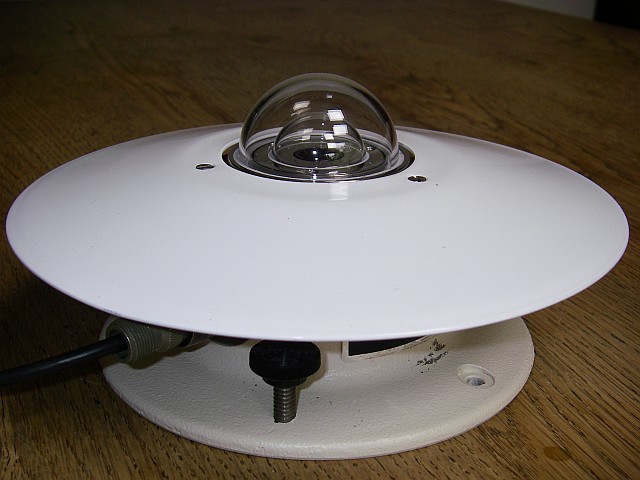
A pyranometer (Greek pur fire, ana, above and metron, measure)
was installed in early November 2008. It is a Eppley PSP pyranometer (Eppley Laboratory, Inc ., Precision Spectral Pyranometer), which is considered a high performance instrument ("First Class" ISO 9060:1990 to ISO (E) "Good Quality" according to the World Meteorological Organization). This model is used in numerous meteorological stations around the world. It measures the irradiance, which is the power of the flow of solar energy reaching the ground per unit area (expressed in watts per square meter W/m²). It is sensitive to a wide range of wavelengths, from infrared to ultraviolet (280 to 2800 nm). As it provides a direct measurement of the flux of solar energy reaching the solar thermal and photovoltaic, it is the most appropriate instrument to measure the performance of these sensors.
The unit has a black surface which heats up by absorbing the incident light radiation. The black surface is in contact with the hot junction of a heat detector that works by thermoelectric effect (thermopile consisting of gold-palladium thermocouples). Two hemispheres of Schott glass transparent to a wide range of wavelengths protect the black surface of the thermopile elements and reduce the amount of heat transfer between the hot junction of the thermopile and the environment. The body of the instrument is solid bronze and is used to provide a reference temperature for the cold junction of the thermopile (reference junction). The thermopile provides a very low voltage, which must be amplified in order to be measured. For our PSP, we built the amplifier described by Harrison and Knight (2006) and we chose an amplification factor of 300 which provides an output voltage of about 3 V for 1 kW/sq m (e.g. radiation reached in mid April when the sky is perfectly clear).
Generally, pyranometers are installed horizontally. They then measure global irradiance, that is to say one that comes from all sources in the hemisphere located above the surface : normal irradiance (flux extraterrestrial directly from the sun) to which is added the diffuse irradiance, which comes from all other parts of the hemisphere (reflection from the cloud and ground distribution by the constituents of the atmosphere, etc.). In our installation, we tilted the pyranometer to put it parallel to the solar panels (at 40.5°, which is the slope of the roof). It measures, therefore, exactly the energy received by the thermal panel and photovoltaic panel. Because of its inclination, the pyranometer is facing the sun more directly than if placed horizontally. The measured irradiance is greater than that which would be provided if the pyranometer was placed horizontally .
In order to check the calibration of a pyranometer, it may be send to the Physikalisch- Meteorologisches Observatorium Davos which hosts the WRC (World Radiation Center) of the WMO (World Meteorological Organization). Another possibility is to compare several identical pyranometers. We have taken the option to acquire several Eppley PSP pyranometers and to compare them. We also have an Eppley 8-48 pyranometer and an Apogee pyranometer. Contrarily to the Eppley PSP or 8-48, the Apogee pyranometer is equiped with silicon photovoltaic cell. The equipment for testing the three Eppley PSP pyranometers is shown below. The Apogee pyranometer is at the bottom right end of the picture. The signal from each Eppley pyranometer is amplified by an amplifier (open metal box) and sent to a Datataker DT505 data logger. A laptop is connected to the datalogger to retreive the recorded data.
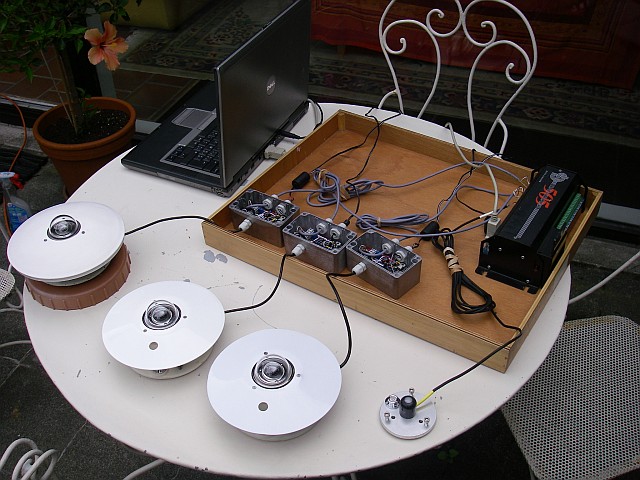
The three Eppley PSP pyranometers we tested gave very similar results. Despite their different ages attested by their serial numbers, we observed virtually no drift in their calibration. The pyranometer at the back was lacking its screen when we acquired it. We have since then made a screen using a stainless steel pot lid which we painted white. The Apogee pyranometer and the Eppley 8-48 pyranometer (not shown in the picture) produced measurements which were different from the three Eppley PSP, which shows that pyranometer can be affected by drift.
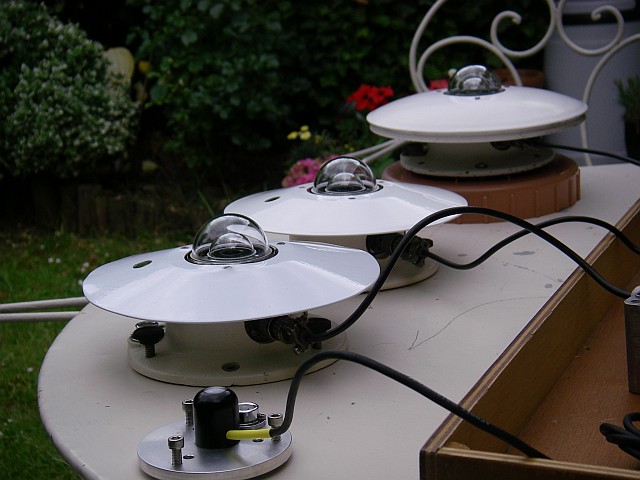
The amplifier, assembled according to the schematics described by Harrison and Knight (2006) is shown below. The amplifier, shown here without its lid, includes a zero offset LTC1100 operational amplifier followed by a LT1006 operational amplifier. A DC-DC 7660 charge pump converter and a 7805 regulator provide the necessary voltage for the op amps from a 12V power adapter.

References :
Bitson, T. (2006) Weather Toys: Building and Hacking Your Own 1-Wire Weather Station, ISBN: 0-470-04046-7
Paperback, 475 pp., weathertoys.net/weathertoys/main.html
Dogniaux, R. (1982) Les rayonnements solaires, atmosphériques et terrestres. Documentation météorologique. Institut royal météorologique de Belgique, 78 pp.
Harrison, R.G. and Knight, J. R.(2006) Thermopile radiometer signal conditioning for surface atmospheric radiation measurements. Review of Scientific Instruments, 77, 116105, p.1-3.
Vignola, F., Michalsky, J. and Stoffel, Th. (2012) Solar and infrared radiation measurements. CRC Press, 394 pp.